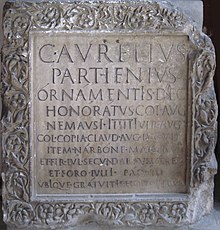Long I
Long i (Latin: i longum or [littera] i longa), written ⟨ꟾ⟩, is a variant of the letter i found in ancient and early medieval forms of Latin script.
In inscriptions dating to the Roman Empire it is used frequently, but inconsistently, to transcribe the long vowel /iː/.[citation needed] In this role it is equivalent to the (also inconsistently-used) apex, which however can appear on any long vowel: ⟨á é í ó v́⟩ /aː eː iː oː uː/. An example would be FꟾLIꟾ, which is generally spelled fīliī today, with macrons rather than apices representing vowel length. On rare occasions an apex could combine with long i to form ⟨ꟾ́⟩.[citation needed]
The long i could also be used to indicate the semivowel [j], e.g. ⟨ꟾVSTVS⟩ or ⟨CVIꟾVS⟩,[1] pronounced /jʊstʊs, kʊjːʊs/. This includes instances of the semivowel /j/ after a consonant, as observed on occasion in Latin poetry, e.g. CLAVDꟾO, representing /klau̯djoː/.
In some forms of New Roman cursive— as well pre-Carolingian scripts of the Early Middle Ages such as Visigothic or Merovingian— it came to also stand for vowels in word-initial position, particularly in the preposition in and its corresponding prefix.[citation needed] For instance ⟨ꟾNponunt ꟾn umeroſ⟩, which would read inpōnunt in umerōs in modern spelling.
 |
 |
 |
References
- ^ Allen, Sydney (1978). Vox Latina: The Pronunciation of Classical Latin (2nd ed.). Gateshead, England: Athenaeum Press. pp. 37–39. ISBN 0-521-22049-1.
See also
External links
- Davud J. Perry (2006-08-01). "Proposal to Add Additional Ancient Roman Characters to UCS" (PDF). Retrieved 2018-09-30. – Adds U+A7FE LATIN EPIGRAPHIC LETTER I LONGA to Unicode.
